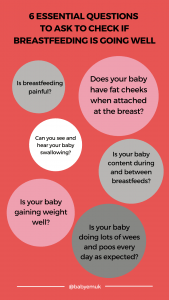If you’re not sure if your baby is breastfeeding well, ask yourself the following questions. This is a basic troubleshooting process that a peer supporter or IBCLC will go through with you, if you’re having a feeding assessment.

Is breastfeeding painful for you?
One of the first things we look for is to check whether breastfeeding is painful for you. As a breastfeeding parent, if you're experiencing any pain, when breastfeeding any nipple damage or trauma, then your baby is probably not positioned well at the breast. This means that may not be getting as much milk as they could be.
Does your baby have fat cheeks when attached at the breast?
The next thing that I'm looking for is ensuring that your baby has nice fat cheeks when they're attached at the breast. If their cheeks are sucking in at the sides, they're making lots of noise, it's possible that they're not latched as optimally as possible. And again, that means they may not be getting as much milk as they need.
Can you see and hear your baby swallowing?
Another sign that your baby is breastfeeding well is when the milk's flowing, you should be able to see and hear your baby sucking and swallowing, and that pattern should roughly be two to three sucks per swallow. You will see this by observing the jaw moving up and down, and then when baby swallows there will usually be a pause after those suckling movements.
Is your baby content during and between breastfeeds?
A baby that is breastfeeding well will likely be content during breastfeeds and in between feeds. It’s important to note that sometimes breastfed babies can be a little bit fussy at the breast when they're going through a growth spurt, and that's part of the way that they stimulate milk supply, so we do need to look at the big picture, but if you've got a baby that's fussy every time they breastfeed, uncomfortable, moving away from the breast, unlatching, trying to get back on, squirming, maybe being really tearful and crying, then it may be a sign that something needs to change to get them breastfeeding more optimally.
Is your baby gaining weight well?
A baby that is breastfeeding well will also be gaining weight really well. Your centile chart will show you whether baby is following the line that they should be. If they're not, and they're dropping through the lines then they may need some additional support to get breastfeeding going a bit better, maybe that their position at the breasts needs changing. It may be something else is going on, but it's worth getting a full feeding assessment just to see what's happening if your baby's not gaining weight as expected.
What’s in their nappy?
We'd also expect a baby that is feeding really well at the breast to be doing lots of wees and poos! Ideally, we'd like to see a baby doing at least two poos a day every day, at least for the first six weeks and this may slow down after six weeks when the composition of breast milk changes. We should still ideally see all babies passing a stool every day. Babies should do six heavy wet nappies from around day four. So, if your baby is not weeing and pooing as expected, or if the poo is an unusual color or consistency, then seeking some feeding support from somebody qualified is really important.
If you have any concerns about the way that your baby is breastfeeding, or if you’re supporting a family that is struggling with breastfeeding, then do seek some support. You can use this link to find an IBCLC.
The earlier you get support in place, the better as this means that breastfeeding can be more comfortable, you can feel more confident and reassured and baby will be getting the amount of milk that they need to thrive.

